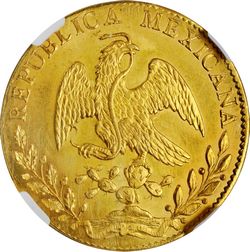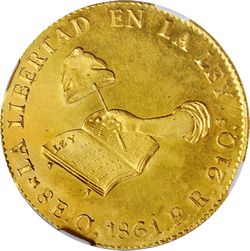The Oaxaca mint
by Pablo Luna Herrerabased on his website (in Spanish) eldatonumismatico
Several decades had to pass for the successful opening of the Oaxacan mint. In July 1842, President Antonio López de Santa Anna authorized its opening in the Department of Oaxaca (to citizen José Joaquín Guergue), likewise, in September 1847, President Ignacio Comonfort authorized its operation[text needed]. However, the multiple armed conflicts and political turmoil of the time, added to the lack of funds, prevented the start of activities.
At first it was argued that it was not possible to open it due to the geographical location surrounded by mountains, the fact that mining production was insignificant until 1850, and the Mexico City Mint had the benefit of exclusivity to manufacture currency within 750 kilometres (Oaxaca is located 450 km from the capital).
The establishment of a mint at Oaxaca was thanks in a large part to the efforts of the influential governor of the state and future president of Mexico, Benito Juárez. lt was Juarez's petition to the Minister of Hacienda on 7 June 1856 that finally led to permission to establish the mint. Lerdo de Tejada, informed the lessees of the Mexico City mint (Bellange and Temple) that "the government reserves the liberty of establishing as it deems appropriate a mint in Oaxaca for the minting of precious metals that are exploited within the same State.”
The contract[text needed] was signed on 11 August 1857. On 25 March 1858 the local Congress authorized its opening, ordering the coining of 100,000 pesos in silver. In Mexico City, General Félix Zuloaga protested its operation, urging its immediate closure, and on 6 May 1858 he mentioned that the coins produced were of poor quality and design. The decree would not be repealed until 15 April 1864, by the Second Empire.
In the opening decree it was foreseen that the Mexico City Mint would provide the new mint with the matrices for making dies, but it is evident from the early crude coinage that this did not happen. By 1861 newspapers in Veracruz were accusing the Oaxacan currency of lacking the stipulated fineness (ley). This may have been the reason that a second mint was opened in Oaxaca in 1861 with coins made in two facilities with different machinery.
The Governor of the state, defending the issues, presented a report (also signed by the assayer Francisco de la Rosa) to the Local Congress on 16 September 1861 in which he showed the benefits in weight and design of the currency of Oaxaca,


KM-383.10. Oaxaca 8 escudos 1861 O-FR (Stack’s Bowers auction, 6 August 2020, lot 21475)
The Imperial forces of Maximilian occupied the mint from 8 February 1865 to 12 September 1866. There is an interesting statement by the Imperial Treasurer, Sr. Villalba, that during the occupation gold and silver were minted in Oaxaca. Since there are no Maximilian issues known from Oaxaca, it is probable that if this is true the coins were made from dies already on hand, probably dated 1864. It is unlikely, however, that the 1865 issue is from this referenced coinage. Minting of 8 Reales resumed after the occupation in 1867 and continued until 1869 when it was abandoned in favor of the Balance Scale Peso. When the new peso proved unpopular, 8 Reales coinage resumed in 1873 and continued until the mint closed in 1893.
The only mint in the republic that was not leased between 1876 and 1879 was the one in Oaxaca. The reason for this singular case is actually very simple: the Oaxacan mint was operating some years with subsidies from the federal government and others with negligible profits; in short, it was not a business despite the heavy investments it had made in machinery and facilities since 1877. Proof of this can be found in the Memoria de Fomento for the fiscal year 1883-1884, where it is reported that the government of the nation had given the Oaxaca mint an annual subsidy of six thousand pesos. In the same vein, the Oaxaca mint, which operated with a percentage of expenses five times higher than the average of the other mintsJuan Fernando Matamala .
The first ten years of issues are quite irregular in terms of the varieties of design, as the dies were of local manufacture. Uniformity with the Mexico City mint would not happen until the end of the Maximilian Empire when the engraver Sebastian Navalon joined the mint (some authors mention in 1881) and sent the official designs that lasted until the closure of the mint in 1893. In 1877 new machinery was installed.
A comparative study of the varieties documented and reported on the 8 reales coins of this mint indicates that there are a total of 103 types from 1858 to 1893Garza, 2021. This article cover the esrly dies.
In later years the Oaxaca mint proved to be the least efficient of the Mexican mints. The cost of minting coins was 10%, or five times that of other mints. With the inauguration of the railroad to Mexico City on 8 December 1892 there was no longer the need for a mint at Oaxaca. , since secure transportation for bullion and coinage was now available. Secretary Romero himself, referring to the case of the Oaxaca mint, said in 1892 that once the railroad line to Mexico City was completed, it would be easy and cheap to transport the precious metals to the capital to be minted in the Mexico City Mint, which would allow the closure of the Oaxaca Mint without causing damage to the miners of the state. In addition, it represents a saving for the public treasury by eliminating the operating expenses of the Oaxacan establishment, actions that could be repeated in some of the other mints in the country. The Oaxaca mint ceased operation and was closed on 31 July 1893.
Mínt owners or lessees and their tenures
| from | to | |
| 25 March 1858 | 4 April 1872 | Government of the State of Oaxaca/lgnacio MejiaIgnacio Luis Antonio Mejía Fernández de Arteaga was born on 1 September 1814. He studied in Oaxaca where he met Benito Juárez. In 1832 he was secretary to the commander of arms of the State of Oaxaca, General Isidro Reyes, and was promoted to captain of grenadiers of the state's National Guard. In 1846 he was a local deputy, and during the American intervention enlisted in the army. At the end of that war, in 1848 he was appointed military governor of Tehuantepec, and then head of the Political Headquarters of the Central District. He was appointed interim governor of Oaxaca from August 1852 to January 1853. He participated during the Ayutla Revolution, and when Antonio López de Santa Anna left the country, he was responsible for organizing the National Guard in the state of Oaxaca. During the presidency of Ignacio Comonfort, he was ordered to fight the Oaxacan governor José María García, who supported the Conservative Party. During the War of Reform he supported the Liberals and the Juárez government. In 1861 he confronted and defeated the troops of Félix Zuloaga, Leonardo Márquez and Tomás Mejía at Real del Monte. In 1860 he was promoted to brigadier general. During the Second French Intervention in Mexico he was the head of the Oaxaca Division and participated in the Battle of Puebla defending the position of Cerro de Guadalupe. He was appointed military governor of Puebla, serving from May 1862 to March 1863. During the Siege of Puebla he was apprehended and sent to France where he was imprisoned. In July 1864 he escaped and returned to Mexico; in October 1865, he rejoined the Liberal forces at Paso del Norte. He was appointed general of division and Minister of War and Navy by Benito Juárez, and held the post from 1865 to 1876, continuing under President Lerdo de Tejada. He was responsible for ordering the military tribunal that tried and sentenced Maximilian, however he opposed the execution of Maximilian and asked President Juárez to commute the death sentence to life imprisonment. When Porfirio Díaz became President of Mexico Mejía was exiled but he returned to Mexico in 1880 and ran for the presidency of the Republic, losing the elections to Manuel González. When Porfirio Díaz was re-elected, he retired from active duty in the Mexican Army and lived his last years at the Hacienda de San Nicolás Ayutla, in Teotitlán del Valle, Oaxaca. He died on December 2, 1906. |
| 4 April 1872 | 31 July 1893 | Government of the Republic of Mexico |
Assayers and their tenures (as evidence by coinage)
| Initial | Name | Began on | Left office on |
| AE | Agustín Endner | 1858 | 1860 |
| 1863 | |||
| 1865 | |||
| 1867 | 1890 | ||
| FR | Francisco de la Rosa | 1861 | 1864 |
| EN | Eduardo Navarro Luna | 1891 | 1893 |
Mintage
Pradeau stated that the Oaxaca Mint minted 5,795,145.95 pesos, of which 763,342 pesos was in gold coin, 5,031,457 in silver coin and finally 346,95 is copper coin.
The amount in thousands of pesos is partially broken down by year:
| Coinages per year (pesos). | |||
| Year | Gold | Silver | Total |
| 1859 | 997.00 | 57,212.00 | 58,209.00 |
| 1860 | 512.00 | 28,565.00 | 29,077.00 |
| 1861 | 13,303.12 | 74,427.06 | 87,730.18 |
| 1862 | 47,404.68 | 158,054.04 | 205,458.72 |
| 1863 | 89,534.54 | 166,232.09 | 255,766.63 |
| 1864 | 53,220.63 | 212,308.36 | 265,529.49 |
| 1865 | 48,734.95 | 202,073.68 | 250,808.63 |
| 1866 | 36,730.63 | 208,752.06 | 245,482.69 |
| 1867 | 46,385.05 | 168,073.96 | 214,459.01 |
| TOTAL: | 336,822.60 | 1.275,698.75 | 1,612,521.35 |
